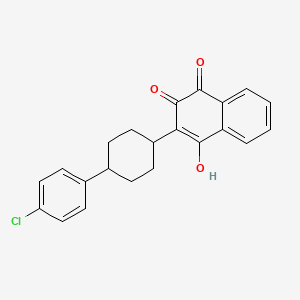D0317 | Atovaquone
P
P01AX06 Atovaquone
[P01AX] Other agents against amoebiasis and other protozoal diseases
[P01A] AGENTS AGAINST AMOEBIASIS AND OTHER PROTOZOAL DISEASES
[P01] ANTIPROTOZOALS
[P] Antiparasitic products, insecticides and repellents
| Pictogram | Signal | Statements | Precautionary Statement Codes |
|---|---|---|---|
  |
Warning |
Aggregated GHS information provided by 47 companies from 7 notifications to the ECHA C&L Inventory. Each notification may be associated with multiple companies. Reported as not meeting GHS hazard criteria by 40 of 47 companies. For more detailed information, please visit ECHA C&L website Of the 5 notification(s) provided by 7 of 47 companies with hazard statement code(s): H315 (28.57%): Causes skin irritation [Warning Skin corrosion/irritation] H319 (28.57%): Causes serious eye irritation [Warning Serious eye damage/eye irritation] H335 (28.57%): May cause respiratory irritation [Warning Specific target organ toxicity, single exposure Respiratory tract irritation] H400 (100%): Very toxic to aquatic life [Warning Hazardous to the aquatic environment, acute hazard] H410 (57.14%): Very toxic to aquatic life with long lasting effects [Warning Hazardous to the aquatic environment, long-term hazard] H413 (14.29%): May cause long lasting harmful effects to aquatic life [Hazardous to the aquatic environment, long-term hazard] Information may vary between notifications depending on impurities, additives, and other factors. The percentage value in parenthesis indicates the notified classification ratio from companies that provide hazard codes. Only hazard codes with percentage values above 10% are shown. |
P261, P264, P271, P273, P280, P302+P352, P304+P340, P305+P351+P338, P312, P321, P332+P313, P337+P313, P362, P391, P403+P233, P405, and P501; (The corresponding statement to each P-code can be found at the GHS Classification page.) |
 |
Warning |
The GHS information provided by 1 company from 1 notification to the ECHA C&L Inventory. H315 (100%): Causes skin irritation [Warning Skin corrosion/irritation] H319 (100%): Causes serious eye irritation [Warning Serious eye damage/eye irritation] H335 (100%): May cause respiratory irritation [Warning Specific target organ toxicity, single exposure Respiratory tract irritation] |
P261, P264, P271, P280, P302+P352, P304+P340, P305+P351+P338, P312, P321, P332+P313, P337+P313, P362, P403+P233, P405, and P501; (The corresponding statement to each P-code can be found at the GHS Classification page.) |
| 1,4-Naphthalenedione, 2-(4-(4-chlorophenyl)cyclohexyl)-3-hydroxy- | 1,4-Naphthalenedione, 2-(4-(4-chlorophenyl)cyclohexyl)-3-hydroxy-, trans- | 1,4-Naphthalenedione, 2-(trans-4-(4-chlorophenyl)cyclohexyl)-3-hydroxy- |
| 1,4-Naphthalenedione, 2-[cis-4-(4-chlorophenyl)cyclohexyl]-3-hydroxy- | 1,4-Naphthalenedione, 2-[trans-4-(4-chlorophenyl)cyclohexyl]-3-hydroxy | 1,4-naphthalenedione,2-(trans-4-(4-chlorophenyl)cyclohexyl)-3-hydroxy- |
| 137732-39-9 | 2-((1r,4r)-4-(4-chlorophenyl)cyclohexyl)-3-hydroxynaphthalene-1,4-dione | 2-(4-(4-Chlorophenyl)cyclohexyl)-3-hydroxy-1,4-nap |
| 2-(4-(4-Chlorophenyl)cyclohexyl)-3-hydroxy-1,4-naphthoquinone | 2-(TRANS-4-(4-CHLOROPHENYL)CYCLOHEXYL)-3-HYDROXY-1,4-NAPHTHALENEDIONE | 2-(trans-4-(4-chlorophenyl)cyclohexyl)-3-hydroxynaphthalene-1,4-dione |
| 2-(trans-4-(p-Chlorophenyl)cyclohexyl)-3-hydroxy-1,4-naphthoquinone | 2-Hydroxy-3-[4-(4-chlorophenyl)cyclohexyl]-1,4-naphthoquinone | 2-[4-(4-Chlorophenyl)cyclohexyl]-3-hydroxynaphthoquinone, trans- |
| 2-[4-(4-chlorophenyl)cyclohexy]-3-hydroxy-1,4-naphthoquinone | 2-[4-(4-chlorophenyl)cyclohexyl]-3-hydroxy-1,4-dihydronaphthalene-1,4-dione | 2-[4-(4-chlorophenyl)cyclohexyl]-3-hydroxy-1,4-naphthoquinone |
| 2-[4-(4-chlorophenyl)cyclohexyl]-3-hydroxy-1,4-napthoquinone | 2-[4-(4-chlorophenyl)cyclohexyl]-3-hydroxy-1.4-naphthoquinone | 2-[4-(4-chlorophenyl)cyclohexyl]-3-hydroxy-naphthalene-1,4-dione |
| 2-[4-(4-chlorophenyl)cyclohexyl]-3-hydroxynaphthalene-1,4-dione | 2-[trans-4-(4-Chlorophenyl)cyclohexyl]-3-hydroxy-1,4-naphthalenedione | 2-[trans-4-(4-chlorophenyl)cyclohexyl]-3-hydroxy-1,4-naphthoquinone |
| 2-[trans-4-(4-chlorophenyl)cyclohexyl]-3-hydroxynaphthalene-1,4-dione | 2-[trans-4-(p-Chlorophenyl)cyclohexyl]-3-hydroxy-1,4-naphthoquinone | 233A184 |
| 3-[4-(4-Chlorophenyl)cyclohexyl]-4-hydroxy-1,2-naphthalenedione | 3-[4-(4-chlorophenyl)cyclohexyl]-4-hydroxy-naphthalene-1,2-dione | 3-[4-(4-chlorophenyl)cyclohexyl]-4-hydroxynaphthalene-1,2-dione |
| 3-[4-(p-chlorophenyl)cyclohexyl]-4-hydroxy-1,2-naphthoquinone | 566C | 566C80 |
| 78668-EP2307343A1 | 94015-53-9 | 95233-18-4 |
| A13708 | AB00053222-03 | AB00053222_04 |
| AB00053222_05 | AB0012456 | AB00513855 |
| AB0107187 | AB0211463 | AC-30251 |
| AK544285 | AKOS005567953 | AKOS015895691 |
| AKOS015961933 | AS-12809 | ATO & IL-12 |
| ATOVAQUONE | Acuvel | Atavaquone |
| Atovakvon | Atovaquone & Interleukin 12 | Atovaquone (Atavaquone) |
| Atovaquone (JAN/USP/INN) | Atovaquone EP Impurity B | Atovaquone [USAN:BAN:INN] |
| Atovaquone [USAN:USP:INN:BAN] | Atovaquone, >=98% (HPLC) | BCP09477 |
| BDBM192009 | BIDD:GT0849 | BPBio1_000603 |
| BSPBio_000547 | BSPBio_002681 | BW 566C |
| BW 566C-80 | BW 566C80 | BW-556C-80 |
| BW-566C-80 | BW-A 566C | C06835 |
| C22H19ClO3 | CAS-95233-18-4 | CCG-220534 |
| CCG-39090 | CHEBI:575568 | CHEBI:95346 |
| CHEMBL222334 | CHEMBL519462 | CRL-8131 & Atovaquone |
| CS-2702 | CTK5H7581 | Cis-2-[4-(4-chlorophenyl)cyclohexyl]-3-hydroxy-1,4-naphthoquinone |
| D00236 | DB01117 | DRG-0084 |
| DSSTox_CID_2629 | DSSTox_GSID_22629 | DSSTox_RID_76664 |
| DTXSID20916694 | DTXSID7022629 | DivK1c_006782 |
| FD7252 | FT-0081084 | FT-0602868 |
| GTPL9695 | HMS1569L09 | HMS1922F19 |
| HMS2089M14 | HMS2093C10 | HMS2096L09 |
| HMS2235N08 | HMS3369N09 | HMS3651N20 |
| HMS3713L09 | HSDB 7083 | HY-13832 |
| J90007 | KBio1_001726 | KBio2_002223 |
| KBio2_004791 | KBio2_007359 | KBio3_001901 |
| KBioGR_001594 | KBioSS_002223 | KS-00000FO3 |
| KUCQYCKVKVOKAY-CTYIDZIISA-N | KUCQYCKVKVOKAY-OTVXOJSOSA-N | KUCQYCKVKVOKAY-UHFFFAOYSA-N |
| LS-178256 | MCULE-7318126574 | MLS002153863 |
| Mepron | Mepron (TN) | Mepron (antipneumocystic) |
| NAP016 | NCGC00016961-01 | NCGC00016961-02 |
| NCGC00016961-03 | NCGC00016961-04 | NCGC00016961-06 |
| NCGC00016961-07 | NCGC00095113-01 | NCGC00095113-02 |
| NSC-759582 | NSC759582 | Pharmakon1600-01504210 |
| Prestwick0_000534 | Prestwick1_000534 | Prestwick2_000534 |
| Prestwick3_000534 | Q418179 | SBI-0052893.P002 |
| SC-15688 | SC-21393 | SCHEMBL1542719 |
| SCHEMBL1649508 | SCHEMBL21694 | SCHEMBL21695 |
| SCHEMBL637069 | SCHEMBL9975142 | SCHEMBL9975229 |
| SMR001233220 | SPBio_001849 | SPBio_002468 |
| SPECTRUM1504210 | SR-05000001438 | SR-05000001438-1 |
| SR-05000001438-2 | SR-05000001438-4 | SR-05000001438-5 |
| STK636160 | SW219222-1 | SpecPlus_000686 |
| Spectrum2_001665 | Spectrum3_000991 | Spectrum4_001117 |
| Spectrum5_001382 | Spectrum_001743 | TX-010638 |
| Tox21_110714 | Tox21_110714_1 | UNII-Y883P1Z2LT |
| Wellvone | Y883P1Z2LT | Z1541632806 |
| ZINC100017856 | ZINC100345537 | ZINC116473771 |
| ZINC12504271 | ZINC299873031 | atovaquone-atavaquone |
| cis -2-(4-(4-chlorophenyl)cyclohexyl)-3-hydroxynaphthalene-1,4-dione | cis-Atovaquone | s3079 |
| trans-2-(4-(4-chlorophenyl) cyclohexyl)-3-hydroxynaphthalene-1,4-dione | trans-2-[4-(4-Chlorophenyl)cyclohexyl]-3-hydroxy-1,4-naphthalenedione | trans-2-[4-(4-chlorophenyl)cyclohexyl]-3-hydroxy-1,4-naphthoquinone |
| DrugBank Name | Atovaquone |
| DrugBank | DB01117 |
| CAS Number | 137732-39-9, 94015-53-9, 95233-18-4, 996-42-9 |
| PubChem Compound | 74989 |
| KEGG Compound ID | C06835 |
| KEGG Drug | D00236 |
| PubChem.Substance | 46507298 |
| ChEBI | 575568 |
| PharmGKB | PA448502 |
| ChemSpider | 10482034 |
| BindingDB | 16301.0 |
| TTD | DAP000156 |
| Wikipedia | Atovaquone |
| HET | AOQ |
| DPD | 8317 |

